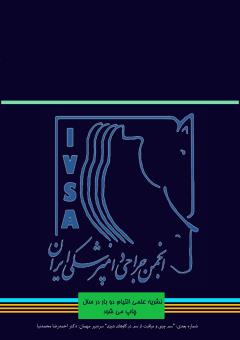Introduce of a Simple and Minimally Invasive Approach for Access to Epidural Space
Subject Areas : Veterinary Soft and Hard Tissue SurgeryAsma Asadian 1 , Mohammad mehdi Dehghan 2 , Majid Masudifard 3 , َAthena Salimi 4
1 - Tehran University
2 - no
3 - NO
4 - NO
Keywords: Spinal cord injury, Per-cutaneous approach, Lumbosacral junction, Cat, Minimally invasive,
Abstract :
Background: Although various researches have been conducted to improve therapeutic strategies in resolving spinal cord injuries, robust clinical treatment is not yet available. Developing a standard animal model is essential before treatment. Objectives: The present study was performed to introduce a simple, applicable, and minimally invasive approach for access to epidural space in cat. Methods: We used per-cutaneous approach from lumbosacral junction for stainless steel cannula insertion to the epidural space. CT-scan, conventional Magnetic Resonance Imaging, tractography, and behavioral evaluation were used to assess the correct position of cannula and neurological condition of the patient. Results: MRI results showed no significant change in signal intensity index of neural structures under lumbosacral junction. These observations were further supported by tractography, and also behavioral examination during study. Conclusions: We found that per-cutaneous approach from lumbosacral junction is a simple and applicable approach which has no side effects and artifact formation in MRI evaluation.
1. Albus, U. Guide for the Care and Use of Laboratory Animals (8th edn), 2012, Washington, DC: The National Academies Press. https://doi.org/10.1258/la.2012.150312
2. Chung, W. H., Lee, J. H., Chung, D. J., Yang, W. J., Lee, A. J., Choi, C. B., Hwang, S. H. Improved rat spinal cord injury model using spinal cord compression by percutaneous method, 2013, Journal of Veterinary Science, 14(3), 329-335.
https://doi.org/10.4142/jvs.2013.14.3.329 PMID: 23820159 3. Hayta, E., Elden, H. Acute spinal cord injury: A review of pathophysiology and potential of non-steroidal anti-inflammatory drugs for pharmacological intervention, 2018, Journal of chemical neuroanatomy, 87, 25-31.
https://doi.org/10.1016/j.jchemneu.2017.08.001 PMID: 28803968 4. Fukuda, S., Nakamura, T., Kishigami, Y., Endo, K., Azuma, T., Fujikawa, T., Shimizu, Y. New canine spinal cord injury model free from laminectomy, 2005, Brain research protocols, 14(3), 171-180. https://doi.org/10.1016/j.brainresprot.2005.01.001 PMID: 15795171
5. Kuchner EF,Hansebout RR, PappiusHM. Effects of dexamethasone and of local hypothermia on early and late tissue electrolyte changes in experimental spinal cord injury, 2000, J Spinal Disorders; 13(5):391–8. https://doi.org/10.1097/00002517-
200010000-00004 PMID: 11052347 6. Lee, J. H., Choi, C. B., Chung, D. J., Kang, E. H., Chang, H. S., Hwang, S. H., Kim, H. Y. Development of an improved canine model of percutaneous spinal cord compression injury by balloon catheter, 2008, Journal of neuroscience methods, 167(2),
310-316. https://doi.org/10.1016/j.jneumeth.2007.07.020 PMID: 17870181 7. Lim, J. H., Jung, C. S., Byeon, Y. E., Kim, W. H., Yoon, J. H., Kang, K. S., Kweon, O. K. Establishment of a canine spinal cord injury model induced by epidural balloon compression, 2007, Journal of veterinary science, 8(1), 89-94. https://doi.org/10.4142/jvs.2007.8.1.89 PMCID: PMC2872703
8. Mattucci, S., Speidel, J., Liu, J., Kwon, B. K., Tetzlaff, W., Oxland, T. R. Basic biomechanics of spinal cord injury—how injuries happen in people and how animal models have informed our understanding, 2019, Clinical biomechanics, 64, 58-68.
https://doi.org/10.1016/j.clinbiomech.2018.03.020 PMID: 29685426 9. Nardone, R., Florea, C., Höller, Y., Brigo, F., Versace, V., Lochner, P., Trinka, E. Rodent, large animal and non-human
primate models of spinal cord injury, 2017, Zoology, 123, 101-114. https://doi.org/10.1016/j.zool.2017.06.004 PMID: 28720322 10. Purdy, P. D., Duong, R. T., White, C. L., Baer, D. L., Reichard, R. R., Pride, G. L., ... & Yetkin, Z. Percutaneous translumbar spinal cord compression injury in a dog model that uses angioplasty balloons: MR imaging and histopathologic findings, 2003, American journal of neuroradiology, 24(2), 177-184. PMID: 12591630
11. Purdy, P. D., White, C. L., Baer, D. L., Frawley, W. H., Reichard, R. R., Pride, G. L., Yetkin, Z. Percutaneous translumbar spinal cord compression injury in dogs from an angioplasty balloon: MR and histopathologic changes with balloon sizes and
compression times, 2004, American journal of neuroradiology, 25(8), 1435-1442. PMID: 15466348 12. Sharif-Alhoseini, M., Khormali, M., Rezaei, M., Safdarian, M., Hajighadery, A., Khalatbari, M. M., Rahimi-Movaghar, V. Animal models of spinal cord injury: a systematic review, 2017, Spinal Cord, 55(8), 714-721. https://doi.org/10.1038/sc.2016.187 PMID: 28117332
13. Shkorbatova, P. Y., Lyakhovetskii, V. A., Merkulyeva, N. S., Veshchitskii, A. A., Bazhenova, E. Y., Laurens, J., Musienko, P. E. Prediction algorithm of the cat spinal segments lengths and positions in relation to the vertebrae, 2019, The Anatomical
Record, 302(9), 1628-1637. https://doi.org/10.1002/ar.24054 PMID: PMC6561844 14. Yang, C., Yu, B., Ma, F., Lu, H., Huang, J., You, Q., & Feng, J. What is the optimal sequence of decompression for multilevel noncontinuous spinal cord compression injuries in rabbits?, 2017, BMC neurology, 17(1), 44. https://doi.org/10.1186/s12883-017-0824-3
15. Yoon, H., Kim, J., Moon, W. J., Nahm, S. S., Zhao, J., Kim, H. M., & Eom, K. Characterization of chronic axonal degeneration using diffusion tensor imaging in canine spinal cord injury: a quantitative analysis of diffusion tensor imaging parameters according to histopathological differences, 2017, Journal of Neurotrauma, 34(21), 3041-3050. https://doi.org/10.1089/neu.2016.4886 PMID: 28173745
16. Yoon, H., Moon, W. J., Nahm, S. S., Kim, J., & Eom, K. Diffusion tensor imaging of scarring, necrosis, and cavitation based on histopathological findings in dogs with chronic spinal cord injury: evaluation of multiple diffusion parameters and their correlations with histopathological findings, 2018, Journal of neurotrauma, 35(12), 1387-1397. https://doi.org/10.1089/neu.2017.5409 PMID: 29298564


